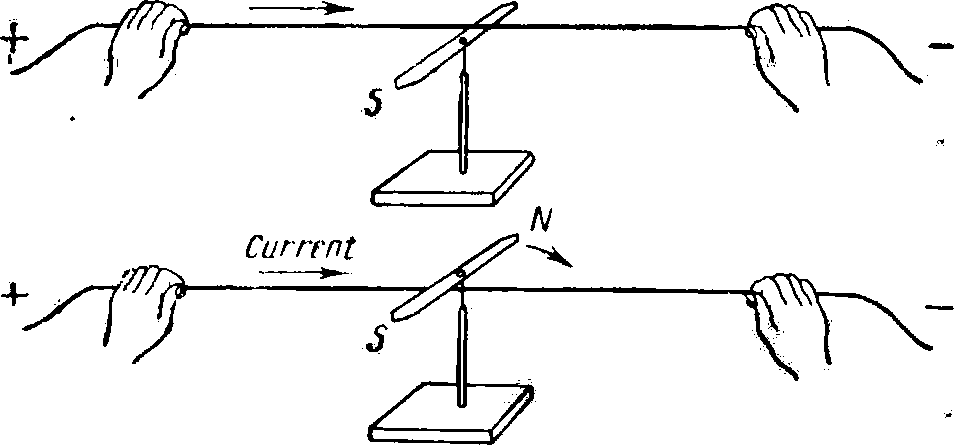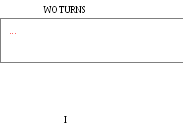
- •Vocabulary 138
- •Electric current serves lis in a thousand ways
- •Exercises
- •Active Words and Expressions
- •Exercises
- •Exercises
- •Lightning
- •Active Words and Expressions
- •Exercises
- •Magnetism
- •Exercises
- •Idioms early history
- •Active Words and Expressions
- •Exercises
- •Lomonosov
- •Active Words and Expressions
- •Exercises
- •Volta's short biography
- •Electric current
- •Active Words and Expressions
- •What is heat?
- •Active Words and Expressions
- •Electric circuit
- •Voltmeter
- •Conductors and insulators
- •Active Words and Expressions
- •Exercises
- •Insulator surface treatment
- •Electromotive force and resistance
- •Active Words and Expressions
- •Exercises
- •Heating effect of an electric current
- •Active Words and Expressions
- •Exercises
- •III. Complete the following sentences:
- •IV. Answer the following questions:
- •V. Translate the following word combinations:
- •VI. Define the meaning of the prefixes in the following words, translate them:
- •IX. Translate tfie following sentences paying attention to the words in bold type:
- •X. Read and retell the following text.
- •If there were no electricity
- •XI. Speak on the heating effect of an electric current.
- •IV. Translate the following sentences and define the functions of tfie word that
- •V. Translate the following sentences paying attention to the words in bold type:
- •VI. Fill in the blanks with suitable prepositions and form sentences with the following infinitives: -
- •VII. Compare:
- •VIII. Translate the following sentences, paying atten- tion to the words in bold type:
- •IX. Form nouns from the following verbs and translate them:
- •X. Give a short summary of the text.
- •XI. Look at Fig. 9 and describe Oersted's discovery.
- •XII. Describe fig. 10.
- •VI. Read the following abbreviations:
- •VII. Define the following terms:
- •IX. Form five sentences combining suitable parts of the sentence given in columns I and II:
- •II. Answer the following questions:
- •IV. Define the following terms:
- •V. (a) Choose the right term; (b) explain the statement:
- •VI. Translate the following sentences:
- •VII. Translate the following text:
- •VIII. Retell the text.
- •Transformers
- •3 Single-pnase transformers stepping generator voltage up to 275.000 volts
- •2300 To 230 volt
- •2300 Volt motor
- •230 Volt induction motor
- •Transmission system
- •IV. Form as many words as possible using suffixes and prefixes. Define what parts of speech the new words are and translate them:
- •V. Form nouns from the following words using suitable suffixes:
- •VI. Translate the following word combinations:
- •VII. Arrange the following words and expressions in pairs of a) synonyms, b) antonyms:
- •IX. Compare:
- •X. Translate the following text:
- •XI. Retell the text
- •IV. Translate the following sentences using the Passive Voice:
- •V. Form sentences according to the models given below:
- •VI. Answer the following questions:
- •IV. Answer the following questions:
- •V. Define the following terms:
- •VI. Form six sentences using the following nouns quali- fied by adjectives:
- •VII. Translate the following text:
- •VIII. Describe Fig. 15.
- •IV. Translate the following sentences:
- •V. Translate the following sentences:
- •VII. Give a heading to each paragraph of the text. Explain why you have given such a heading.
- •VIII. Speak on:
- •IX. Translate the following text:
- •Active Words and Expressions
- •Exercises
- •IV. Translate the following words and word-combinations:
- •V. Answer the following questions:
- •VIII. Speak on the possible uses of solar energy.
- •IX. Read and retell the following story;
- •1. Energy
- •2. Electric fish
- •4. Surface tension
- •5. Electric meter
- •7. Refrigerator
- •10. Electron theory
- •11. Thermocouple and photocell
- •12. Electric lamp
- •13. Faraday's discovery
- •15. Steam turbine
- •16. Units of measurement
- •17. Plasma generator
- •18. Laser
- •19. Semiconductors
- •20. Steam power station
- •21. Hydroelectric power station
- •22. Current flow
- •23. Gases, solids, liquids and plasma
- •Idioms, Conjunctional and Prepositional Phrases
- •Vocabulary
- •Impulse wheel ['impals ,wi:l] активная турбина
IX. Translate tfie following sentences paying attention to the words in bold type:
1. The faster the molecules of a substance move, the higher is the temperature of the substance. 2. The larger the water pipe, the more water passes through it. 3. The more you read, the more you learn. 4. The shorter the wire, the less is its resistance to current flow. 5. The greater the number of free electrons in a substance, the better that substance conducts electricity.
X. Read and retell the following text.
If there were no electricity
At present it is difficult even to imagine the time when * there was no electricity, when people had to do without it.
What would our everyday life be like if there were no electricity?
Can you imagine a situation when all devices producing electricity would stop operating?
If this happened in the evening while you were in the cinema, you would be sitting in the dark without light. Then you would walk along dark streets. You would try to take a trolley-bus or a tram, it would be impossible. As there would be no light at home, you should use either a smoking kerosene lamp or a candle.
You would like to use the telephone or to watch TV but they would not work because they both depend upon the electric current. This example shows the importance of electricity in everyday life.
XI. Speak on the heating effect of an electric current.
LESSON SEVENTEEN
THE COMPLEX SENTENCE
MAGNETIC EFFECT OF AN ELECTRIC CURRENT
The invention of the voltaic cell in 1800 gave electrical experimenters a source of a constant flow of current. Seven years later the Danish scientist and experimenter, Oersted, decided to establish the relation between a flow of current and a magnetic needle. It took him at least 13 years more tp find out that a compass needle is deflected when brought near a wire through which the electric current flows. At last, during a lecture he adjusted, by chance, the wire parallel to the needle. Then, both he and his class saw that when the current was turned on, the needle deflected almost at right angles towards the conductor. As soon as the direc- tion of the current was reversed, the directionjthe needle pointed in was reversed too. :
As seen in Fig. 9 the north end of the needle moves away from us when the current flows from left to right. Oersted
Current ^\ N

Fig. 9. Influence of an electric current on a compass needle.
■ •
also pointed out that provided the wire were adjusted below the needle, the deflection was reversed.
The above-mentioned phenomenon highly interested Ampere who repeated the experiment and added a number of valuable observations and statements. He began his research under the influence of Oersted's discovery and carried it on throughout the rest of his life.
Everyone knows the rule thanks to which we can always find the direction of the magnetic effect of the current. It is known as Ampere's rule. Ampere established and proved that magnetic effects could be produced without any magnets by means of electricity alone. He turned his attention to the behaviour of the electric current in a single straight conductor and in a conductor that is formed into a coil;i.e. (that is) a solenoid.
When a wire conducting a current is formed into a coil of several turns, the amount of magnetism is greatly increased.
It is not difficult to understand that the greater the number of turns of wire, the greater is the m.m.f. (that is the magnetomotive force) produced within the coil by any constant amount of current flowing through it. In addition, when doubling the current, we double the magnetism generated in the coil (See Fig. 10).
A solenoid has two poles which attract and repel the poles of other magnets. While suspended, it takes up a north and a south direction exactlv like the compass needle. A
4
4
![]()




![]()
Fig. 10. a) The number of turns of wire in the coil affects the magnetic strength, b) The strength of the current through the coil influences the magnetic strength of the coil.
core of iron becomes strongly magnetized if placed within the solenoid while the current is flowing.
When winding a coil of wire on an iron core, we obtain an electromagnet. (That the electromagnet is a controllable and reliable magnet is perhaps known to everyone, vlt is, so to say, a temporary magnet provided by electricity. Its behaviour is very simple. The device is lifeless unless an electric current flows through the coil. However, the device comes to life provided the current flows. The iron core will act as a magnet as long as the current continues to pass along the winding.
Active Words and Expressions
to add, angle, to adjust, as soon as, coil, constant, core, deflection, electromagnet, to establish, to find out, needle, to repel, rule, straight, turn
Exercises
/. Translate the following sentences:
1. A current-carrying coil of wire which is long in comparison with its diameter is called a solenoid. 2. The experiments Oersted carried on attracted Ampere's attention. 3. The electric circuit can be closed, if necessary. 4. It was Ampere who showed the difference between the current and the static charges. 5. That the unit of current is named after the famous French physicist Ampere is probably known to you. 6. When placing an iron core within a solenoid, we obtain an electromagnet. 7. The phenomenon Oersted pointed at interested Ampere greatly. 8. We know that the direction of the magnetic effect of the current can be found thanks to Ampere's rule. 9. If suspended so that it can rotate freely, the solenoid points north and south when the current flows.
//. Fill in the blanks with suitable words given below: where, which, when, who, that,
1. We know ... Oersted established the relation between the flow of electric current and a magnetic needle. 2. The great scientists Volta, Ampere and Yablochkov may be named among those ... have greatly contributed to electrical engineering. 3. The end ... the lines of force leave the coil after passing through its core will act like a north magnetic pole. 4. ... there is a certain connection between electricity and magnetism was proved by experiments. 5.... he placed the wire parallel to the needle he saw ... the needle deflected. 6. A wire ... is wound in the form of a solenoid acts like a magnet as long as it is carrying a current.
///. Answer the following questions:
1. When was the voltaic cell invented? 2. What did Oersted decide to establish? 3. What did he find out? 4. When did the needle deflect? 5. Who repeated Oersted's experiments? 6. Do you know Ampere's rule? 7. What did Ampere establish and prove? 8. When is magnetism greatly increased? 9. Is the magnetic effect produced when the charges are at rest? 10. What is an electromagnet? 11. When does the iron core act as a magnet?
